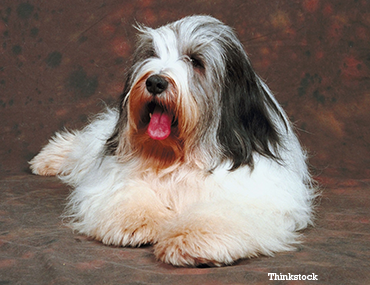Background
It seems as though the Polish Lowland Sheepdog developed in Central Asia with the Tibetan Terrier and the Lhasa Apso. Since the Tibetan people loved to trade, the dogs made their way across Asia and into Europe. There they were intermixed with other working dogs. The PON has been a herding and flock-guarding dog in Poland since the 15th century.
The Polish Lowland Sheepdog was recognized by the American Kennel Club in 2001.
Sizing up
- Weight: 35 to 55 lbs.
- Height: 17 to 20 inches
- Coat: Thick, long, shaggy double coat
- Color: Any color or pattern: white, gray, and brown with black are most common
- Life expectancy: 10 to 12 years
What’s the Polish Lowland Sheepdog like?
The Polish Lowland Sheepdog is intelligent and affectionate with a strong herding instinct. He is devoted to his family and is great with kids and other pets as long as he is raised with them; he may try to herd children into one area so be careful that he doesn’t do this excessively. He can adapt well to various conditions and is a great companion dog for someone living either in the country or in the city. He requires moderate exercise; a couple of walks per day will make him happy.
The Polish Lowland Sheepdog has an excellent memory and is easily trainable but you need to make sure he knows you’re the alpha dog. The training process should begin right away because he can get a little stubborn as he matures.
Grooming your PON can be a little time consuming; you may want to set aside an hour per week to keep his hair free of mats and tangles. Use a bristle brush to comb it out and make sure you get all the way down to the skin.
Health
The Polish Lowland Sheepdog is typically a healthy breed but watch for any of the following:
- Hip dysplasia
- Progressive retinal atrophy
- Hypothyroidism
- Neuronal ceroid-lipofuscinosis
Takeaway Points
- The Polish Lowland Sheepdog is extremely easy to train.
- The Polish Lowland Sheepdog is highly adaptable and can live in virtually any environment.
- The Polish Lowland Sheepdog is more high maintenance than some other breeds when it comes to grooming.
If you have any questions or concerns, you should always visit or call your veterinarian -- they are your best resource to ensure the health and well-being of your pets.
